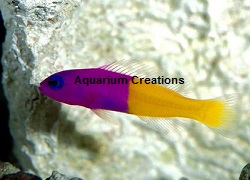Bicolor Dottyback
Pseudochromis paccagnellae

Identification:
The Bicolor Dottyback also called the Bicolor Pseudochromis is native to the tropical reefs of the Central Indo-Pacific. As one of the hardiest and undemanding reef fish available, the Bicolor Dottyback is an excellent choice for beginners as well as the more experienced hobbyists. The Bicolor Dottyback has clear fins and has a beautiful color combination of a front half that is solid, bright-purple to hot-pink and a rear half that is a vivid, bright-yellow; which is how it got its name. There are no special markings, although some specimens exhibit a very thin vertical line where their dual coloration merges in the middle; the color of the line is exactly what you would expect to see from mixing the other two colors.
Tank Recommendations:
Dottybacks require an aquarium of at least 30 gallons and with a rock-associated lifestyle should be provided with plenty of live rock and hiding places. They are middle to bottom dwellers that generally mix well with other reef inhabitants, but are territorial and can become aggressive towards other Dottybacks or similar-shaped fish.
Food and diet:
Dottybacks are carnivorous and naturally prey upon small shrimp, amphipods, copepods and bristleworms. In the aquarium they should be fed a variety of meaty foods such as live, frozen, freeze-dried, and vitamin enriched brine shrimp, finely chopped mysis shrimp, finely chopped krill and other sea foods; as well as carnivore/omnivore pellets and flake foods. To preserve the stunning coloration of a Dottyback, variety and vitamins are very important (their beautiful color may fade without them). Feed 1 to 2 times per day.
Level of Care:
Easy
Acclimaton Time:
2+ hours
Reef Compatibility:
Excellent
Approximate Purchase Size:
1-1/4" to 2"
|
|

